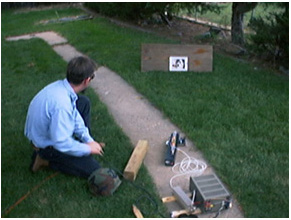


We decided not to use the carbon dioxide laser with the Laser Light show because:
1) The beam is invisible and 2) It can burn holes in things from ten feet away!



LASER is the acronym for "Light Amplification by Stimulated Emission of Radiation." Laser light differs from conventional light in several aspects. Even though both are electromagmetic in nature, laser light has certain properties that make it highly desirable in a multitude of fields and applications. Unlike conventional light, laser light is highly monochromatic, that is, pure light of almost a single wavelength or small line width (bandwidth). It is also temporally and spatially coherent. One may think of temporal coherence as a source of light where if the observer were to snap a picture of the wave, he would observe a group of peaks and valleys occurring with equal separations or wavelengths. This quality of the light contributes to the sharp line width approaching spectral purity. Temporal coherence is the time relation of the field intensity at a particular point in space. Spatial coherence of the wave now is tbe valley and peaks remaining stationary relative to space and position. It is this characteristic that gives the laser beam directionability due to the minimal constructional and destructional interferences. We shall refer to laser light as being both temporal and spatially coherent and spontaneous light as being random and unsynchronized.
Atoms absorb or emit energy in thc form of electromagnetic waves as a result of electrons changing from one energy level to another. These energy levels are numerous and well defined being characteristic of the particular atom in question. They also have an equivalent frequency response defined as resonance that is functional of the difference in energy of these levels as stated by the familiar relation E = hfc.
Absorption is the result of electrons jumping from a lower state to a higher state (excitation) taking energy at the resonant frequency from the system. Typical are the spectral lines of absorption in spectrographic analysis. An excited atom may now contribute this energy to a system in the form of spontaneous or stimulated emission. Spontaneous emission is the random natural decay of these higher energy levels dropping to their normal lower
rest levels and emitting energy equivalent in wavelength to that particular transition. This energy equivalent bandwidth is broad and incoherent. Energy must obviously be externally supplied to the atom for it to achieve a higher energy state.
Stimulated emission is the reciprocal process of resonant absorption and it only occurs when a population inversion is produced. A population inversion is when a higher energy level contains more population than its lower counterpart. When this occurs stimulated emission is easily obtained by photons of energy near to that of the inverted transition now triggering other identical electrons to drop to a lower level producing the in-phase coherent emission energy characteristic of the laser beam.
The trick is to create this necessary population inversion between these levels in question, by forcing, or pumping externally. Achieving this unnatural phenomena is accomplished by several different means, usually depending on the particular laser in question. The usual means is to excite a medium containing three or more involved energy levels. These levels are usually pumped either electrically or optically to their respective excited states. If part of this decay from the highest level drops down to the intermediate level and adds to the population, temporarily causing it to have more population than the ground level, this creates the population inversion necessary for stimulated emission between the intermediate and ground levels. This emission when directed between two mirrors such as a Fabry-Perot resonator is reflected back through the laser medium many times stimulating more photons and exiting the device as a powerful beam of energy.